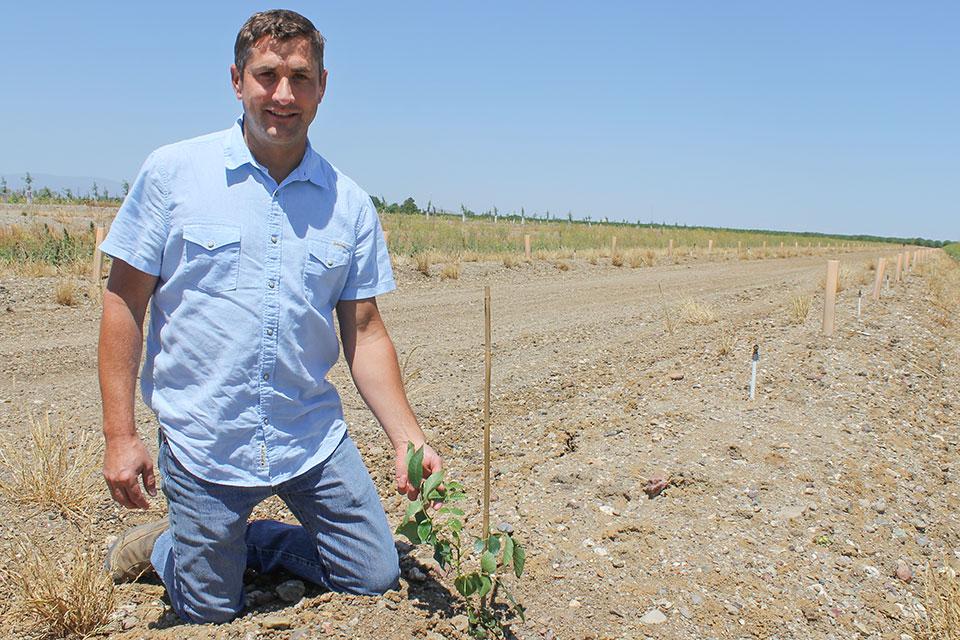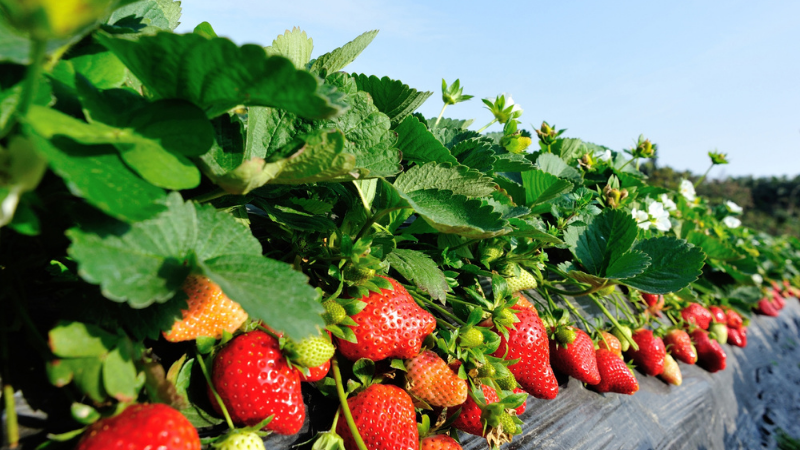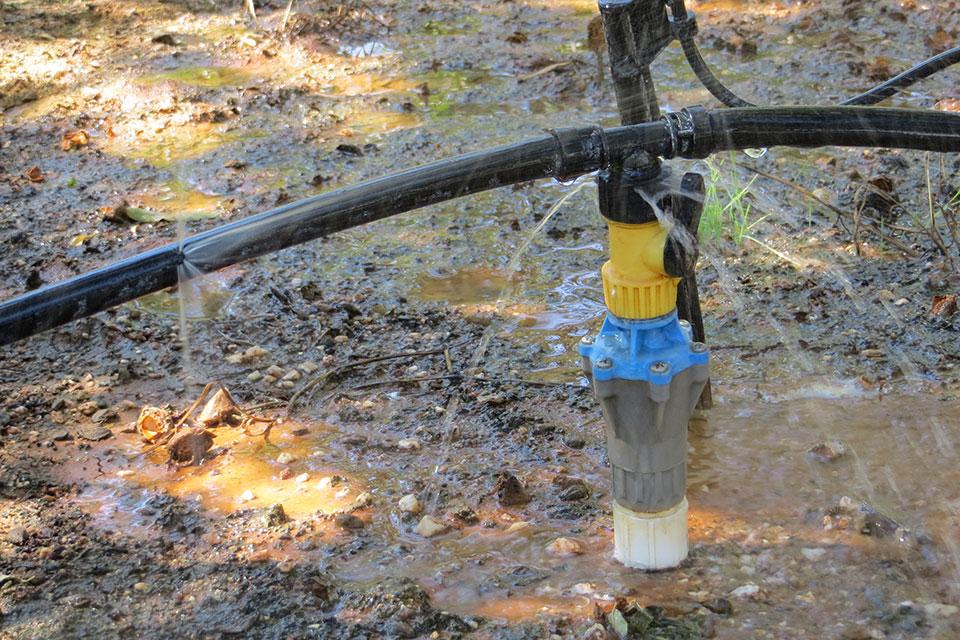Max Yield in the Field: How Precision Irrigation Hits the Right Spot

This past spring, Leon Etchepare of Emerald Farms planted a new orchard in nearby Artois, CA, with clonal walnuts, variety ‘VX-211’. The orchard features precision irrigation — an eye-popping 26 different watering zones.
Photo by David Eddy
Leon Etchepare was driving through the Sacramento Valley one recent day when he slowed his pickup truck and pointed to a line of walnut trees of very different heights, from about 15 to 35 feet, in the distance. “See that,” he said, “that’s all due to soil type.”
Etchepare and his father Allen own Emerald Farms of Maxwell, CA, where they farm about 1,700 acres of almonds and 2,600 acres of walnuts, as well as seed for dozens of vegetable crops. Leon represents the fourth generation of Etchepares to work the farm, which was founded in 1918 by his great grandfather, an indentured servant from France who worked as a shepherd and then developed his own herd.
Leon Etchepare worked in other jobs after graduating from college before returning to the farm 10 years ago. His time away gave him a newfound perspective on the land, he says, that is most definitely grounded.
“When I came back to the farm, I concentrated on soil health,” he says, “because that’s where it all starts.”
But you can only improve soil health so much. After all, if you’re farming in rocky soil, you’re not going to change it into a rich loam. One thing you can control, however, is the moisture level of the dirt you’re farming, and Etchepare soon realized that was going to be the key to healthy trees and large, consistent yields.
First, they stopped flood irrigating because that was clearly not optimizing each tree’s growing environment.
“We’re not trying to save water, we’re just trying to use the right amount,” he says. “But that often means saving water.”
Emerald Farms began trying a lot of technology, starting with pressure bombs to measure plants’ water potential, and then later installing Sentek moisture sensors. They found a lot of the trees weren’t getting enough water, while still others were getting over-irrigated.
But in a lot of situations, it wasn’t the amount of the irrigation that was the problem; it was the state of the soil. For example, Etchepare found in some situations that there was a lack of water penetration, which could generally be rectified by adding a whole lot of gypsum.
“We learned we needed to change the way we irrigate and in some cases the irrigation system,” Etchepare says. “We also learned that when you employ a lot of technology, there is a lot to manage.”
GOLDEN OPPORTUNITY
Changing an irrigation system is easier said than done, however. In most cases, a system must be installed prior to planting. That’s why, when Emerald Farms was able to acquire a 500-acre parcel in nearby Artois, the Etchepares were excited by the prospect of a blank canvas on which to work.
The field has 26 different irrigation sections, each based on a different soil type. The irrigation plan is so detailed that one small (1.5-acre) section of the farm is irrigated differently than the sections surrounding it.
“It’s all about soil health and soil type,” he says. “If you don’t have healthy soils, you don’t have healthy trees.”
There are a total of 34 valves on the 500 acres, and they’re all needed, Etchepare says.
“Different soil types require different irrigation treatments and timing,” he says, “and there are 26 different soil types, everything from clay loam to sand and gravel.”
They used a device that looks like a sled, which is dragged behind an all-terrain vehicle, that can “take pictures” of the ground, “seeing” deep into the soil. They also took countless soil samples, measuring such qualities as soil salinity and water-holding capacity, then used that information to build a detailed map of the orchard. The map will help guide exactly how much water is put on.
“The orchard is just planted, so we’re still watering it a lot to keep the small root zone wet,” he says. “But once it grows up, the irrigation timing will ensure water will be going to the root zone. It could be 36 hours of continuous irrigation, or it could be as little as just a few hours, whatever is needed. With this system, we hope to even growth, yield, and harvest timing throughout the orchards.”
START SAVING WATER NOW
Designing a new irrigation system for a farm is obviously the best approach to efficient water use, especially for so-called permanent crops such as tree nuts. But what if you’re not developing new acreage and you just want to save water on the land you already farm?
You don’t have to go high-tech; in fact, you don’t have to invest in any new technology at all. Just focus on bringing your existing irrigation system up to par. That starts with the most basic step of all — fixing leaks. It seems almost laughable at first because on one hand it seems rather obvious, and on the other, would that really save much water?
Tom Devol is now Senior Manager of Field Outreach and Education for the Almond Board of California (ABC), but for years before that he worked in water technology and has experience with virtually every type of irrigation system. He says he never would have guessed that simple leaks could make so much of a difference.
One day he was talking to Kevin Greer, Manager of the Tehama County Resource Conservation District Mobile Irrigation Lab, when they spotted a leak and decided to measure the impact.
“You walk by it, you would say it’s nothing, just a little drip,” Devol says. “Well that little drip was 10,000 gallons in one season. One little drip.”
The leak was at a pump station where the filter was leaking at a gasket, and such leaks can likely be found in orchards everywhere. “That’s why we were looking at that single leak, to get that information across to growers: How much can be lost in a single leak? That’s how much, 10,000 gallons.”
Growers might argue that the water just drains into the aquifer recharging the groundwater, but that’s obviously not efficient, says Devol. And besides, leaks can cause other problems such as mudholes that can develop into real problems. But the key point is that it’s just one leak.
“How many others don’t you see? That’s what I’m trying to get across to growers. That’s just a single leak, and look at the amount of water,” he says. “Besides, this is low-hanging fruit for a grower.”
MAINTAIN YOUR DU
Besides simply wasting money, Devol emphasizes leaks can wreak havoc with an orchard’s distribution uniformity (DU), a measurement of how evenly water is applied across an orchard. A DU rate of 90% means that the area receiving the least amount of water gets about 12% less water than the average area of the orchard, while the area receiving the most gets about 12% more water than the average.
Contrast that with a low DU rate of 75%, in which the low and high percentages are about 30% — and potentially greater. This drastic variance results in significant under- or over-watering of trees within the orchard.
“Better uniformity means more consistent yields and maximizes water use and nutrient applications,” Devol says. “Not only is this a win for the grower, it’s a win for the broader almond industry as it continues to strive to achieve its 2025 goal of increasing water use efficiency.”
To get on top of your irrigation system, it’s best to start with a DU evaluation from a professional, as it’s difficult for a grower to do alone, Devol says. He estimates it takes a team of two to four people about half a day to do an evaluation on a 100-acre orchard. They will check all the emitters, the line pressure, and flow rates at multiple locations in the orchard to see if they’re delivering the same amount of water.
The best systems will achieve a DU of about 95, Devol says, and a well-maintained system can keep that up for some time. But after a couple of years, even the best systems will see some blockage.
In some areas in California, the ABC has partnered with local Resource Conservation Districts so growers can get DU evaluations conducted at no cost. But even if you can’t get it done for free, Devol says growers shouldn’t hesitate to get their irrigation systems tested.
“Definitely try to do it every three years,” he says. “Even if the grower does have to pay, it will pay for itself many times over.”











